What links the results of medical trials, telescopes and the shape of a pine cone? Sounds like the start of a joke from the Edinburgh Festival Fringe. In fact, the answer is maths.
I work in the Learning and Programmes team to showcase the maths we are using every day, with or without realising it. I also look for the unusual and beautiful maths in our lives and hidden in the objects at National Museums Scotland.
Maths Week Scotland is a celebration of maths taking place from 10 to 16 September, with events and online resources by universities and groups all over Scotland. There are events for those who love maths, and those who have had a rockier relationship with it.
The Maths Week Scotland events and activities look at the world and unpick the maths behind it, from our weekly shops to curing cancer. Across our sites, school pupils will getting hands on with maths. In Get Energised: Power House pupils will be using maths to investigate renewable energy at the National Museum of Scotland, whilst in Field to Fork they will be using measuring and weighing skills to make their own bread at the National Museum of Rural Life. For adults who like their maths with an engineering flavour, the Institute for Civil Engineers will be hosting Pitch 200! at National Museum of Scotland. Civil Engineers will have just 200 seconds to explain their favourite engineering concept in unconventional ways.
Throughout our galleries in Edinburgh, we find maths everywhere. Maths underpins and explains the objects and actions we may take for granted. In Fashion and Style, the pieces demonstrate designers’ knowledge of pattern and shapes, as well as arithmetic and geometry, which is required to plan, measure, cut and assemble materials. In World Cultures, we can see how different techniques were developed for mapping and navigating at sea, ranging from using stars and telescopes, to measuring distance and speed with a knotted rope.

The Science and Technology galleries are also bursting with maths. Sometimes it is obvious, such as wave machine on Leve 5 (Energise), which brings to life the sine waves that many of us will remember drawing onto graph paper in school.

Other times the maths is hidden. If we look closely, we can find it in on Level 3 (Communicate), underpinning the development of technologies we use every day. A piece of cable doesn’t seem like the most glamorous object in the Museum, but it contains mathematical problems still being figured out.

There are many mathematical issues behind sending messages through cables. This was true in the first days of the telegraph and remains true in today’s vast communications networks.
Telegraph cables transmitted information using electrical pulses, however, in the early days of sending telegrams, only one message could be sent at a time (more information in this blog post). This is useful if you want to send very few simple messages, but less so for extensive global communication. Fibre-optic cable, introduced in the 1980s, allowed us to send many bits of information at the same time, using light pulses, which travelled at near the speed of light.

We still use networks of cables for the internet, television and phone calls – and with a growing reliance on communication, we need to solve the problem of how we can send more information. Options include increasing the number of cables, or maximising our use of existing cables through multiplexing. Multiplexing required understanding and applying the principles by which electricity works, to order or combine messages in the most efficient way. This can include using different frequencies or combining multiple messages into one message then separating them at the other end. Framing and solving these problems all involve maths. Efficient multiplexing has been the ambition of communications engineers since messages were first sent along wires in the form of electric pulses.

This challenge of capacity and speed for communication is key to improving our ability to keep the stock market working, chat to our aunt in Brazil and for sending those all-important cat memes. The maths may not be obvious in a piece of cable but it is in nearly everything we do, including receiving this blog post.
We can use maths to explore, understand and improve the world around us. Follow @mathsscot or check out the Maths Week Scotland website to get involved and see maths from a different angle. No previous maths enthusiasm required.
